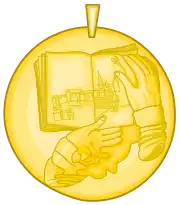Gerardo Diego | |
|---|---|
 Portrait by Emeric Tauss Torday | |
| Born | Gerardo Diego Cendoya 3 October 1896 Santander, Spain |
| Died | 8 July 1987 (aged 90) Madrid, Spain |
| Seat I of the Real Academia Española | |
| In office 15 February 1948 – 8 July 1987 | |
| Preceded by | Blas Cabrera |
| Succeeded by | Claudio Rodríguez |
Gerardo Diego Cendoya (October 3, 1896 – July 8, 1987) was a Spanish poet, a member of the Generation of '27.
Diego taught language and literature at institutes of learning in Soria, Gijón, Santander and Madrid. He also acted as literary and music critic for several newspapers.
Biography
Diego was born in Santander. He studied the subjects of Philosophy & Humanities at the University of Deusto, and later at the universities of Salamanca and Madrid, where he earned his doctorate. With Juan Larrea, he founded the Ultraísta Movement in 1919. He was professor of literature and music. He began his poetic work with El romancero de la novia (1920).
After discovering the Chilean poet Vicente Huidobro, founder of the Creationist movement, Diego became one of the most enthusiastic followers of Creacionismo. The extensive poetic work of Diego has always varied between the themes and expressions of Vanguardism and the more classical structures of poetry. In 1925, he was awarded the National Prize for Literature for his book Versos humanos. He began to publish the journal Carmen y Lola, of Vanguardist character, in 1927. In 1932 he published Poesía española contemporánea.
Diego was elected to seat I of the Real Academia Española, he took up his seat on 15 February 1948.[1] His lifetime accomplishment was recognised with the Cervantes Prize in 1979.
He died in Madrid, in 1987, aged 90.
See also
References
- ↑ "Gerardo Diego - letra I". Real Academia Española (in Spanish). Retrieved 26 May 2023.
External links
- Fundación Gerardo Diego (in Spanish)
